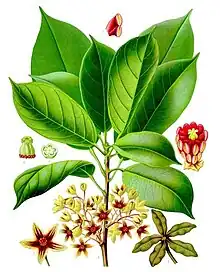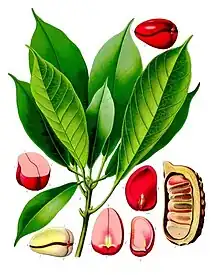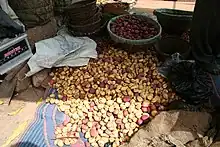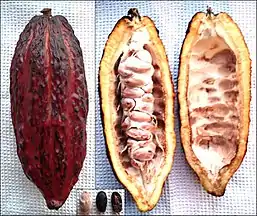Kola nut
The kola nut is the seed of certain species of plant of the genus Cola, placed formerly in the cocoa family Sterculiaceae and now usually subsumed in the mallow family Malvaceae (as subfamily Sterculioideae). These cola species are trees native to the tropical rainforests of Africa. Their caffeine-containing seeds are about 5 centimetres (2.0 in) across and are used as flavoring ingredients in beverages applied to various carbonated soft drinks, from which the name cola originates.[1]

General description



The kola nut is a caffeine-containing nut of evergreen trees of the genus Cola, primarily of the species Cola acuminata and Cola nitida.[2] Cola acuminata, an evergreen tree about 20 meters in height, has long, ovoid leaves pointed at both the ends with a leathery texture. The trees have cream flowers with purplish-brown striations, and star-shaped fruit consisting of usually 5 follicles. Inside each follicle, about a dozen prismatic seeds develop in a white seed-shell. The nut has a reddish or white color flesh on the inside, and has a sweet and rose-like aroma.[1]
Kola nuts contain about 2–4% caffeine and theobromine,[2] as well as tannins, alkaloids, saponins, and flavonoids.[3]
Uses
The kola nut has a bitter flavor and contains caffeine. The nut is a nervous system stimulant and is chewed in many West African countries, in both private and social settings.[1][4] It is often used ceremonially, presented to chiefs or guests.[5][6] Throughout history, kola nuts have been planted on graves as part of various rituals.[1] Laborers in many countries also grow kola nuts in efforts to fight fatigue and hunger, while Brazilians and people of the West Indies use the nut as a remedy for hangovers, intoxication, and diarrhea.[7]
In folk medicine, kola nuts are considered useful for aiding digestion when ground and mixed with honey, and are used as a remedy for coughs.[8]
Kola nuts are perhaps best known to Western culture as a flavoring ingredient and one of the sources of caffeine in cola and other similarly flavored beverages, although kola nut extract is no longer used in major commercial cola drinks such as Coca-Cola.[1][9]
History
Human use of the kola nut, like the coffee berry and tea leaf, appears to have ancient origins.[1] The spread of the kola nut across North Africa seems to be connected to the spread of Islam across North Africa during the 17th century, as trading across the Mediterranean became more concrete. The kola nut was particularly useful on slave ships to improve the taste of water, as enslaved Africans were often given poor quality water to drink.[10] A French voyager named Chevalier Des Marchais, who traveled to West Africa in the late 1720s, noted that the nut made the, "bitterest, our sourest Things taste Sweet after it."[10] These sweet alterations are attributed to the chemical substances that the nut adds to one's palate or the sheer amount of caffeine.[10]
Kola nuts were used as an ingredient within Coca-Cola and Pepsi-Cola in 1886 and 1888 respectively.[6] Kola nuts are an important part of the traditional spiritual practice, culture, and religion in West Africa, particularly Niger, Nigeria, Sierra Leone, Democratic Republic of Congo and Liberia.[1][11]
Cola recipe

In the 1880s, a pharmacist in Georgia, John Pemberton, took caffeine extracted from kola nuts and cocaine-containing extracts from coca leaves and mixed them with sugar, other flavorings, and carbonated water to invent Coca-Cola, the first massive cola soft drink.[1] Although the exact details of the cola recipe remain confidential, as of 2016, the cola recipe no longer contained actual kola nut extract.[1][12]
Cultivation
Originally a tree of the tropical rainforest, it needs a hot humid climate, but can withstand a dry season on sites with a high ground water level. It may be cultivated in drier areas where groundwater is available. C. nitida is a shade bearer, but develops a better spreading crown which yields more fruits in open places. Though it is a lowland forest tree, it has been found at altitudes over 300 m on deep, rich soils under heavy and evenly distributed rainfall.
Regular weeding is necessary, which can be performed manually or through the use of herbicides. Some irrigation can be provided to the plants, but it is important to remove the water through an effective drainage system, as excess water may prove to be detrimental for the growth of the plant. When not grown in adequate shade, the kola nut plant responds well to fertilizers. Usually, the plants need to be provided with windbreaks to protect them from strong gales.
Kola nuts can be harvested mechanically or by hand, by plucking them at the tree branch. Nigeria produces 52.4% of worldwide production followed by the Ivory Coast and Cameroon.[13] When kept in a cool, dry place, kola nuts can be stored for a long time.[14]
The crop's value makes it one of the most important indigenous cash crops in West Africa and is used as a means of social mobility.[1]
Pests and diseases
The nuts are subject to attack by the kola weevil Balanogastris cola. The larvae of the moth Characoma strictigrapta that also attacks cacao bore into the nuts. Traders sometimes apply an extract of the bark of Rauvolfia vomitoria or the pulverised fruits of Xylopia and Capsicum to counteract the attack on nursery plants. The cacao pests Sahlbergella spp. have been found also on C. nitida as an alternative host plant. While seeds are liable to worm attack, the wood is subject to borer attack.
Major producers
| Country | Weight (tonnes) |
|---|---|
| 166,895 | |
| 57,923 | |
| 47,126 | |
| 24,296 | |
| 8,097 | |
| 613 | |
| World | 304,950 |
Total world kola nut production is 304,950 tonnes (300,130 long tons; 336,150 short tons). Nigeria accounted for 55% of the kola nut production in 2020.[16]
Chemical composition
Preliminary studies of phytochemicals in kola nut indicate the presence of various constituents:[2]
- caffeine (2–3.5%)
- theobromine (1.0–2.5%)
- theophylline
- methylliberine
- polyphenols
- phlobaphens (kola red)
- epicatechin
- D-catechin
- tannic acid
- carbohydrate
- water
Society and culture
Used in cultural traditions of the Igbo people, the presentation of kola nuts to guests or in a traditional gathering shows good will.[17] It is implemented in Yoruba religion both as an offering to orishas and as an instrument of divination.[18]
A kola nut ceremony is briefly described in Chinua Achebe's 1958 novel Things Fall Apart. The eating of kola nuts is referred to at least a further ten times in the novel showing the significance of the kola nut in pre-colonial 1890s Igbo culture in Nigeria. One of these sayings on kola nut in Things Fall Apart is: "He who brings kola brings life."[19] It is also featured prominently in Chris Abani's 2004 novel GraceLand.[20] The kola nut is also mentioned in The Color Purple by Alice Walker, although it is spelled "cola".[21]
The kola nut is mentioned in Bloc Party's song "Where is Home?" on the album A Weekend in the City. The lyric, setting a post-funeral scene for the murder of a black boy in London, reads, "After the funeral, breaking kola nuts, we sit and reminisce about the past." The kola nut is mentioned in the At the Drive-In song "Enfilade" on the album Relationship of Command. The kola nut is repeatedly mentioned in Chimamanda Ngozi Adichie's novel Half of a Yellow Sun, which also features the phrase: "He who brings the Kola nut brings life."
Gallery
 Seeds of true / "female" kola (= Cola acuminata) compared and contrasted with those of bitter / "male" kola (= Garcinia kola)
Seeds of true / "female" kola (= Cola acuminata) compared and contrasted with those of bitter / "male" kola (= Garcinia kola) Cocoa pod: fruit of (true) kola relative Theobroma cacao bisected to show similarity of structure to that of fruit of Cola acuminata
Cocoa pod: fruit of (true) kola relative Theobroma cacao bisected to show similarity of structure to that of fruit of Cola acuminata
References
- Veronique Greenwood (23 September 2016). "The little-known nut that gave Coca-Cola its name". BBC News - Future. Retrieved 23 December 2019.
These days, the Coca-Cola recipe is a closely guarded secret. But it's said to no longer contain kola nut extract, relying instead on artificial imitations to achieve the flavour
- Burdock, G. A.; Carabin, I. G.; Crincoli, C. M. (2009). "Safety Assessment of Kola Nut Extract as a Food Ingredient". Food and Chemical Toxicology. 47 (8): 1725–32. doi:10.1016/j.fct.2009.04.019. PMID 19394393.
- E. I. Adeyeye & O. O. Ayejuyo, Chemical composition of Cola acuminata and Garcinia kola seeds grown in Nigeria, International Journal of Food Sciences and Nutrition, Volume 45, 1994 - Issue 4.
- Lovejoy, Paul E. “Kola in the History of West Africa (La Kola Dans L'histoire De L'Afrique Occidentale).” Cahiers D'Études Africaines, vol. 20, no. 77/78, 1980, pp. 97–134. JSTOR 4391682. Accessed 15 Mar. 2021.
- "Kola Nut". Igbo insight guide to Enugu and Igboland's Culture and Language. igboguide.org.
- Starin, Dawn (2013). "Kola nut: so much more than just a nut". The Royal Society of Medicine. 106 (12): 510–512. PMC 3842857.
- "Kola nut | plant | Britannica". www.britannica.com. Retrieved 2023-04-16.
- Odebunmi, E. O.; Oluwaniyi, O. O.; Awolola, G. V.; Adediji, O. D. (2009-01-01). "Proximate and nutritional composition of kola nut (Cola nitida), bitter cola (Garcinia cola) and alligator pepper (Afromomum melegueta)". African Journal of Biotechnology. 8 (2). ISSN 1684-5315.
- "Cola recipe". This American Life. 1992.
- Carney, Judith Ann (2011). In the shadow of slavery : Africa's botanical legacy in the Atlantic world. Richard Nicholas Rosomoff. Berkeley [Calif.]: University of California Press. ISBN 978-0-520-94953-9. OCLC 759158601.
- Aina Adewale-Somadhi (2004). Practitioner's Handbook for the IFA Professional. Ile Orunmila Communications. p. 1. ISBN 978-0-9714949-3-0.
- Meyers, C. (6 May 2011). "How Natural Is Your Cola?". Science NOW.
- "Top Producing Countries of Kola Nut". Tridge. Retrieved 2019-12-29.
- "From Nigeria, the Kola nuts are here". Daily Nation. Retrieved 2017-12-28.
- "Kola nut production in 2020, Crops/Regions/World list/Production Quantity (pick lists)". UN Food and Agriculture Organization, Corporate Statistical Database (FAOSTAT). 2022. Retrieved 10 September 2022.
- The Complete Book on Jute & Coir Products (with Cultivation & Processing).
- Osuagwu, Bertram I. N.; Pritchett, W (March 28, 2003). The Igbos and Their Traditions (PDF). p. 1. Archived (PDF) from the original on 2022-10-09. Retrieved July 30, 2018.
- Barber, Karin (July 1981). "How man makes God in West Africa: Yoruba attitudes towards the Orisa". Africa. 51 (3): 724–745. doi:10.2307/1159606.
- Achebe, Chinua (1958). Things Fall Apart. Johannesburg, South Africa: Heinemann. p. 6. ISBN 978-0-435-90525-5.
- Abani, Chris (2005). GraceLand: A Novel. Farrar, Straus and Giroux. ISBN 978-1-4299-2982-0.
- Walker, Alice (1992). The Color Purple. Houghton Mifflin Harcourt. p. 160. ISBN 978-0-15-119154-3.